
The Retrogaming Times
- The Bimonthly Retrogaming Hobbyist
Newsletter -

The Retrogaming Times
- The Bimonthly Retrogaming Hobbyist
Newsletter -
| The Retrogaming Times |
|
|
As days turn cold and nights grow long, we present to you our final issue of 2016. This issue also marks the completion of our first year in publication. So before we get started this issue, I want to extend a heartfelt thank you to all our readers. Thank you for your continued patronage! I extend an extra special thank you to everyone who has helped to get the word out about The Retrogaming Times by following us on Facebook, blogging about the newsletter, sharing release notifications, giving us mentions on podcasts, and simply talking about our humble publication. Our readership has steadily grown over every issue and the involvement of the great retrogaming community is hugely responsible for that. However there wouldn't be anything to talk about if it wasn't for our awesome staff. The biggest thank you has to go out to my fellow staff members at The Retrogaming Times, without a doubt. It is a pleasure to read your submissions each issue and nothing makes me happier than to see a fresh article ready for editing in the staff inbox. The only thing that comes close to rivaling that is when I receive an article submission from a new name or an e-mail asking about contributing to the newsletter. The central idea of The Retrogaming Times was to keep the spirit of Tom Zjaba's original Retrogaming Times alive; that is a retrogaming publication open to everyone - both as readers and writers. If this first year of The Retrogaming Times has shown me anything, it is that the spirit of a hobbyist driven retrogaming newsletter is not only alive and well, but thriving in the hearts and minds (and thumbs) of retrogamers around the world.
This issue's cover story is a look at a wide variety of games based on Konami properties that appeared on the Commodore 64, including some that may surprise you. It's just the type of story that has made Merman's More C64! one of the most popular columns in The Retrogaming Times. Although arcades in the west aren't as prevalent as they once were, they're starting to make a comeback as Donald Lee reports on the rejuvenation of the arcade scene in his area. While Sega may be considered a small player these days, in 1999 they made one last run to become a worldwide console powerhouse with the Dreamcast. This new hardware brought with it new ideas and a new controller, which Todd Friedman takes a look at in The Controller Chronicles. It may be our last issue of the year but if you "hunger" for a unique gameplay experience, then you won't want to miss Mighty Matt D.'s Retrogaming Feels concerning Sinistar. We welcome new contributor Jerry Terrifying to the newsletter as he recalls good times gaming with good friends. And of course I continue working down the list on the CoolBoy 198 in 1 Famicom pirate multicart, revealing some of the best two-player NES games, and some of the worst home arcade conversions.
If you have comments or questions about
anything covered in the newsletter or there is something you would like
featured in The Retrogaming Times, let us know via The Retrogaming Times
on Facebook at facebook.com/theretrogamingtimes
or contact me directly at trt@classicplastic.net! It fills me with
an overwhelming sense of both pride and humility to welcome you to this
issue of The Retrogaming Times.
|
Return of the Pacific Pinball Exposition, November 10th - 13th 2016, Alameda, California, USA
The Pacific Pinball Museum presents the largest collection of working pinball machines from the 1930s to present day with this year's "Shoot The Moon" Pacific Pinball Expo honoring the Golden Age of Pinball. Housed in our new storage facility at Alameda Point (1680 Viking Street, Alameda), this is our biggest show yet!
This three-day Pinball extravaganza will add up to an amazing experience that is fun for the whole family. The Pacific Pinball Expo (PPE) is just a quick walk to the Hornet Aircraft Carrier Museum, and a short drive to restaurants, hotels and beautiful Alameda beaches.
All proceeds benefit the efforts of the Pacific Pinball Museum, a 501(c)3 non-profit dedicated to pinball preservation and fun!
For more information and to purchase tickets, visit http://pacificpinball.org/events/shoot-moon-pinball-expo
~ ~ ~
Sac Gamers Expo, December 11th 2016, Sacramento, California, USA
A video game convention featuring special guests, panels, work shops, vendors, food trucks, displays, artists, game developers, tournaments, console gaming room, viewing room, video game museum, video game music and so much more! Sac Gamers Expo is a family oriented event for all levels of gamers.
For more information and to purchase tickets, visit http://www.sacgamersexpo.com/
~ ~ ~
Pintastic Pinball & Game Room Expo, July 6th - 8th 2017, Sturbridge, Massachusetts, USA
Do you love pinball? Are you looking for a little relief from the hot summer sun? Look no further than Pintastic New England, which is the first of its kind, centrally located in Sturbridge, Massachusetts. This expo is 30,000 square feet of fun for the whole family. The kids can have never-ending excitement with a caricature artist, face painting, balloon animals, magic, and relieve all of their pent-up energy with a bouncy house. The adults can bring out their inner child with over 200 pinball machines set on free play, all while enjoying an ice-cold beer.
For more information, visit https://pintasticnewengland.com/
~ ~ ~
If there is a show or event you would like listed here, free of charge, please contact David directly at trt@classicplastic.net. Please include a short official blurb about your event along with any relevant links or contact information and it will be published in the next issue of The Retrogaming Times. The event listing will remain posted until the issue following the event date.
Check out these great events, shows,
and conventions and let them know you read about them in The Retrogaming
Times!
|
Many great publishers produced games for the Commodore 64, and arcade specialists Konami was among them. Let's take a look back at the highs and lows.
Note that we have to make a distinction here in what we mean by Konami's C64 games. There are:
- Arcade conversions from
Konami titles, created & published by other developers.
- Titles published by Konami
itself, principally through Konami USA.
- Games published by Ultra
Software, the Konami label originally intended to allow them to publish
more NES/Famicom titles each year.
Further confusion can come from the regional
names given to certain releases. For example, the classic Contra
was published in Europe under the alternative titles Gryzor and
Probotector.
CONVERSIONS
One of the earliest Konami titles to reach the C64 was Track & Field in 1984. The classic button-basher actually appeared on the Atarisoft label and was a reasonable attempt. Oddly it got a re-release as a Konami title in 1987. For collectors there is the special pack containing the game and the dedicated Track & Field 3-button controller (with a standard 9-pin DIN plug, the buttons map to left, right and fire). The follow-up Hypersports was particularly memorable for the music. Created by Ocean's in-house musician Martin Galway, this was an amazing cover of Chariots of Fire by Vangelis.
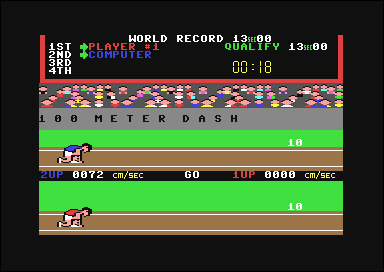
The opening event of
Track & Field on the C64, the 100m Dash
From Konami's early days come conversions of Circus Charlie (published by Parker Brothers) and Pooyan (published by Datasoft). Gradius (Nemesis) was developed in the UK by programmer Simon Pick and scored highly in reviews. The follow-up Lifeforce (known as Salamander internationally) received praise for attempting to recreate the arcade graphics, but there were flaws and omissions.
When Ocean Software took over the bankrupt Imagine label, it was used for several important conversions. Rush ’n Attack (Green Beret in Europe) was a big hit developed in-house at Ocean. Contra (Gryzor) managed good sales too, but was hampered by using the Space bar to make the hero jump. Perhaps least well known is Ping Pong, a minor hit in arcades for Konami but a game that did receive home conversions. Comic Bakery is another obscurity rescued but excellent music from Martin Galway. And beat 'em up Yie Ar Kung Fu made its way to home computer too, with Ocean developing an exclusive sequel (that also appeared on the MSX). A personal favourite was Mikie.
Worst of the lot was the terrible conversion of Jail Break. Poorly designed graphics, flickering sprites and atrocious gameplay ruin any appeal. Another oddity was the conversion of Jackal. Both UK and US versions were produced independently. Around the same time Iron Horse was converted but only saw the light of day in the US.
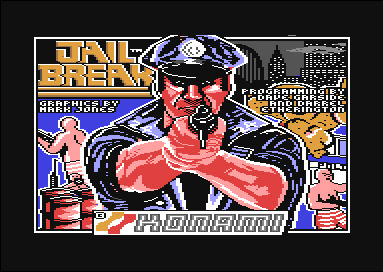
The loading screen from
Jail Break; don't bother playing it!
After Ocean's long association with Konami,
there was a series of releases from Konami USA (and its subsidiary Ultra)
that never made it to Europe. These are, perhaps, the most interesting
and famous brands.
SNAKE!
It's not well-known that there was a C64 version of Hideo Kojima's original Metal Gear. It was released on the Ultra label. Based on the NES version, C64 fans can select the pack of cigarettes from the inventory, listen to Codec calls and indulge in some stealthy action. After the initial sequence sees Snake parachute in, he must contact operative Grey Fox and infiltrate the Outer Heaven base to stop the enemy's weapon (the titular Metal Gear) from becoming active. Available on disk only, it is possible to save the game at various points and resume later.
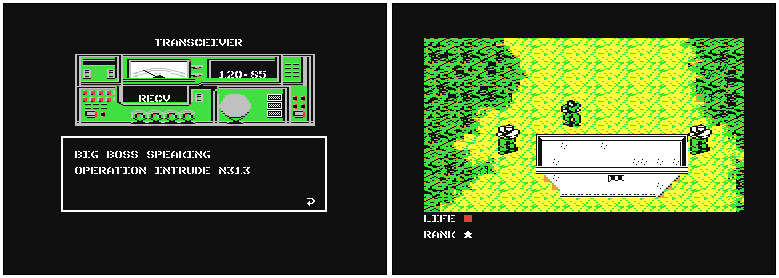
The C64 version of Metal
Gear included the transceiver as seen in other games (left), Run away or
fight the guards in Metal Gear (right)
WHIP IT!
The classic Castlevania also appeared in C64 form. A nice attract mode is followed by a recreation of the intro from the original (and the coin-op Ghost Hunter) with Simon Belmont outside the castle gates. The C64 whip is not as flexible as the NES equivalent, with fire and up used to throw the secondary weapons (such as the axe and dagger). But all the other classic gameplay is intact - whip candles and walls to find hidden bonuses, face waves of enemies and big bosses.
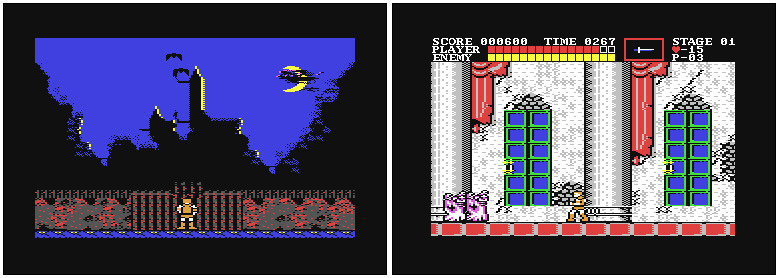
The famous intro sequence
of Castlevania recreated on the C64 (left), Fighting the ghosts in stage
1 of C64 Castlevania (right)
HIT THE ICE!
Blades of Steel was a very successful arcade game for Konami, featuring all the violence of real hockey. Its standout feature was the fist fights between players. Ultra published the C64 conversion in the States, and it plays a reasonable game of hockey.
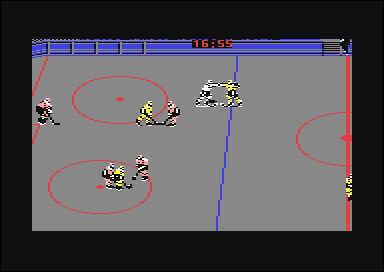
Fists fly in Blades of
Steel
I GET 500 DOLLARS JUST FOR HEY HEY
Konami's arcade division turned out several hit beat 'em ups inspired by cartoon franchises. The 4-player The Simpsons machine was a lot of fun, but the C64 version was only released in the United States - despite being developed by a Hungarian team. It all kicks off with a highly impressive intro sequence based on the cartoon show and the arcade game. Large portraits of the characters are interspersed with animated sequences. After choosing a character (Bart, Homer, Marge or Lisa) another animation explains the story of the game. The Simpsons run into Smithers stealing from the jewellery store, resulting in Maggie swallowing a valuable diamond. Smithers grabs her and the family members set off in pursuit.
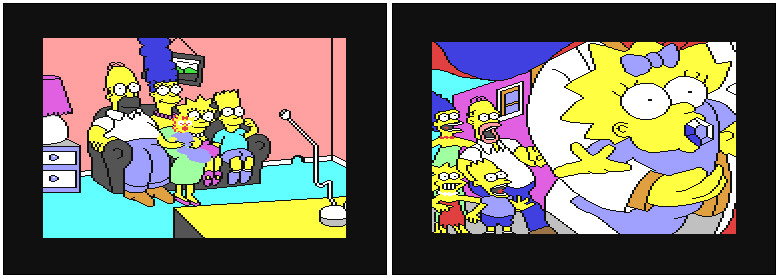
Two of the impressive
bitmaps telling the story of The Simpsons game
Hordes of enemies fill the streets of Springfield, Krustyland and other locations. There are big bosses - including the wrestler Werner von Brawn - to be defeated. It's a case of bashing the button to unleash punches, kicks and other moves on the enemies, or the player can pick up street objects including signs to be thrown at them instead. The presentation is excellent throughout but it does become a heavy multiload on disk. Difficult to track down and valuable for collectors, emulating reveals what an ambitious conversion this was.
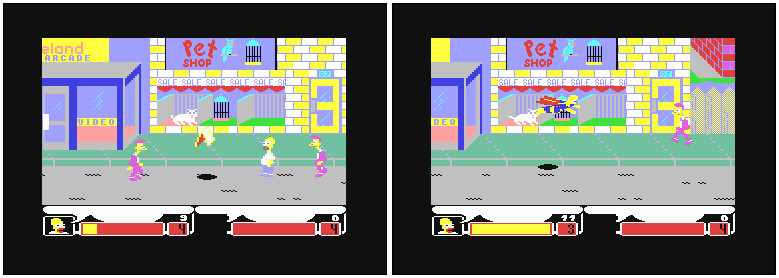
Objects including signs
can be thrown. When Homer dies, his brief invulnerability is shown by him
becoming Super Homer
Konami also published two C64 games based
on the Teenage Mutant Ninja Turtles. The NES game from Ultra became
a disk-heavy C64 title, but for Europe a programming team was brought in
to convert it to work from cassette. The popular arcade beat 'em up also
made the leap, given the title Teenage Mutant Ninja Turtles - The Arcade
Game to distinguish it from the earlier game. Two turtles could play
simultaneously in Probe's conversion, featuring detailed graphics and excellent
sound.
So there we have it, a look back at Konami's C64 legacy. There are some interesting titles in there to explore, especially if you have never played them or only know them from another format.
And if you want to find the definitive
collection of C64 games, then check out Gamebase 64 at www.gb64.com.
Version 15 has just been released, taking the total number of games preserved
to 25,700!
|
Fall is here. Fall is my favorite season - the air turns crisp, you can turn off your air conditioning, and it is more socially acceptable to stay indoors and play video games! Add in the sugar rush from all the Halloween candy and you might be ready to play this issue's game with feeling - 1982's Sinistar.

I don't remember Sinistar being a huge hit in the pre-crash video game world. This might have been because of all the fierce competition in the arcade industry at the time, or because at first glance it seems to be a simple space shooting game. After seeing Space Invaders, Galaxian, Galaga, Asteroids, Bosconian, and a host of other hits all set on a black starry background, it wouldn't be surprising if arcade goers saw Sinistar as being more of the same. The players that gave it their time and their quarters, however, were richly rewarded with a frantic gaming experience that was full of firsts in the arcade world.
For me, the game drew me in immediately because of its apparent simplicity. To understand the feelings Sinistar imparted on me, I need to first talk about its proper environment - the early 80's video game arcade. I understand that many readers of this fine website have fond memories of this time and place already, but let me indulge if only for the purpose of trying to paint a picture for those readers who weren't indoctrinated to the arcade scene until the fighting game craze of the 90's or even later.
In 1982, a quarter was actually worth something. Wow, that made me sound old. Moving on. It was almost enough to buy a candy bar or a soda. So, the prospect of spending one on a video game that probably would last only a minute or two really required some forethought. Many times I would walk into an arcade with only a dollar to my name. I would walk around the floor several times, watching other kids play, or the attract mode of vacant machines. Even games I was already familiar with would have to be reconsidered. Did I want to try Donkey Kong again in hopes of finally clearing the elevator stage? Play it safe by dropping yet another quarter in the familiar Galaga? Or try a game that I'd seen many times but just hadn't yet convinced me to take the plunge?
The other consideration was that the arcade itself was typically packed, at least on the weekends. Teenagers and twenty-somethings alike would crowd around machines, yelling, cursing, banging fists on control panels and generally being quite boisterous. It was a good time for all. For every game being played, there were often at least one or two spectators, and they usually did not watch quietly. Most games were designed to be single player, or two player alternating at most, so oftentimes the spectators were anxious to get their turn and would fix their eyes on the game in progress, offering up comments and appraisals of the players skill whether they were wanted or not. The effect of this was for me to take into consideration how well I might do before putting my quarter on the game's marquee to hold my place in line. An embarrassing showing coupled with the loss of a precious quarter was not welcome!
With Sinistar, there wasn't any of this painful deliberation. I knew from the moment I saw it that it would be taking my quarters. Love at first sight. Or first sound I should say. Sinistar was one of the first arcade games to feature digitized speech, and the sound of Sinistar yelling "Run, coward!" at the teenager playing the game got me to stop in my tracks and take notice. An occasional "I hunger" will be bellowed by the monster - and the indignant look on a new player's face the first time they see their ship get eaten by it is priceless.
Watching a game in progress could almost be considered audio assault if the volume is up high enough. And what self-respecting arcade owner didn't turn every game up as high as it would go? Usually the Aladdin's Castle I frequented was noisier than my school lunchroom. The player's ship flies around the void of space shooting at asteroids and enemies alike as in, well, Asteroids, but the pace of it is blindingly fast compared to Atari's vector graphics classic. Each explosion of rock or spaceship is accompanied by a deep throated "Crackle - BOOM" sound, and there are many of these. The key is that there are several variations of this, so it doesn't seem repetitive. This is punctuated by high pitched beeps indicating that Sinistar, your nemesis, has grown by another piece. When combined with the sounds of your ship's laser fire (which is near constant), it all layers into a sonic fury that demands attention.
Having bypassed my usual evaluation phase in favor of watching only the tail end of another kid's game, my first attempt at Sinistar was brutally short. It was immediately followed by another, and another still. I started to make sense of what was going on in the maelstrom of activity. The asteroids aren't just rocks to block your path, but rather hold crystals which needed to be collected to create Sinibombs. The Sinibombs are needed to destroy Sinistar, which is what the little red enemies are constantly flitting about trying to build using the same minerals you are after. An intermission screen between lives shows the progress of the build with the last piece being the mouth. The timeless battle over resources plays out at warp speed, and being the first with the most is essential to survival.
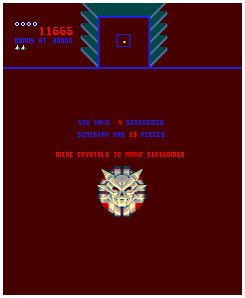
He's ready to party and
four Sinibombs ain't gonna cut it.
Image courtesy arcade-museum.com
The game drew me in because it seemed to be a simple case of shooting everything that moves, and for the most part that's exactly what it is. You have no friends amongst the rocks and the stars here. There are no powerups and there is no safe haven. I've always liked a good shoot-em-up, and I still do. Sometimes I just want to react rather than reason. Not having a plan or formulating any strategy is so liberating. There is no time for planning - the speed of Sinistar simply doesn't allow for it.
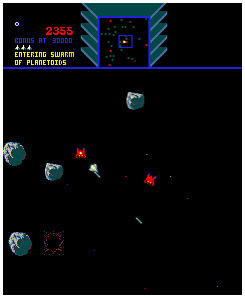
Shoot the rocks.
Shoot the red guys. Just... shoot. And move. Quickly.
Image courtesy arcade-museum.com
Sinistar himself is obviously the big attraction here, however. Once he is completed everything else becomes much less important. He is a boss encounter in a game that existed before any of us knew to call it a boss encounter. There is no doubt even in the first time players mind that whatever that giant face is it needs to be destroyed. He taunts and relentlessly pursues your ship until he either devours you or you destroy him in a flurry of Sinibombs that sends him screaming into the abyss. No matter how many times I see him go down, it is always satisfying. And when he screams "Run, Coward!" and you are short on Sinibombs, well, you better do it.
Having a quick trigger finger is rewarded here - as is quickly gathering the precious crystals. Reaction time is everything, and a well played game of Sinistar can be a serious adrenaline rush. The enemies will rush in quickly from all directions and the only solution is to point and shoot.
With so few options at the player's disposal, it was important that the designers of Sinistar made the controls fluid and precise, and they came through in spades. A unique feature of the arcade cabinet is its 49 direction optical joystick. That's right - 49 unique directions. Offering near-analog flexibility with digital precision, the stick allows you point your ship just so as needed to take out one of the plethora of enemies that seem to surround you at all times. You'll need it, as the frictionless playfield gets slippery and the precision aiming is all that saves your sanity in your fight to mine the rocks, gather the crystals, and destroy enemy cannons all simultaneously. Unless you are seriously dedicated, this feature will be missing from your home setup so it makes finding a real arcade cabinet worth the effort.
I had a unique experience with Sinistar while attending a friend's birthday party at the local Chuck E. Cheese. The place was new back then - I must have gone there for five or six birthday parties at least, including my own. I understand that now it is mostly filled with ticket redemption games, sort of a Las Vegas for children. But back then it was all about animatronic mice, bad pizza, and the same hit arcade games that were popular everywhere else. It was during this particular party that I spied the deluxe environmental Sinistar cabinet. I rushed over and settled in, excited to be able to play in this format. I dropped at least half of the handful of tokens I'd been given into the coin slot before realizing that I was able to start a new game simply by hitting the start button. That game ended and sure enough I was able to start another. I'd won the jackpot of arcade gaming! I played several times before letting the other kids know about the bonanza of free games. Being able to play without the angst of burning through all of my tokens in minutes allowed me to enjoy it to the fullest.
I love the sit down cabinets - I feel like these were the first forays into virtual reality. If there is ever an opportunity to play a sit down (sometimes called "environmental") version of a game, any arcade game, do it. The Sinistar environmental cabinet features stereo sound and the heavy bass of the explosions vibrate through the wood and into the seat. It's a rumble pack for the whole body, and is not to be missed. Feelings of being completely encapsulated by the game almost made me forget everything else that was going on outside - and for me, the escapism that goes with a good game is a selling point. I know Chuck E. Cheese was packed with screaming rambunctious kids that day, but short of one of them climbing into the game with me (for small children, the cabinet can work as 2 seater), I never gave them a second thought.
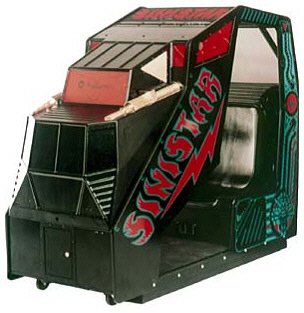
This may as well be a
cocoon - so long as the constant threat of destruction is comforting to
you.
Image courtesy arcade-museum.com
I probably didn't play Sinistar for nearly a decade after its heyday. The arcade scene dried up, and it disappeared from view along with so many other greats. Naturally other games filled the void, and I honestly didn't give it much thought until the mid nineties. That's when I got a PlayStation, and when I saw the Williams Arcade's Greatest Hits disc with the Sinistar logo displayed on the label, I purchased it without another thought.
The PlayStation was obviously a pretty huge deal for a lot of reasons, but this particular game really struck a chord with me because it was the first time I had been able to play a truly arcade perfect version of a game at home. I saw it as being a tremendous value - the disc cost me $20, and I know I've dumped much more than that on games like Joust, Robotron, and of course Sinistar over the years. Seeing that these games had been so lovingly preserved, complete with programmer interviews, and knowing I could now play them as much as I wanted gave me a warm fuzzy feeling. It made me know that other people missed these games too. I'm fully aware that even a low end PC and Internet connection means you can emulate almost any 80's game for free, but I still have a soft spot for collections like this and always pick them up when I see one I don't have.
You'd think that with all this time spent
on the game I'd be a champion player. I got decent enough at it when
I picked up the PlayStation collection, but Sinistar is quite a tough cookie.
It has a reputation for being brutally difficult, to the point that some
consider too tough to enjoy. Knowing these games were basically designed
to eliminate the player in a few minutes to make way for the next quarter
makes me feel better about my mediocre scores. Sinistar yells and
hungers, and I find myself yelling right back at him. Being one step
away from a frustrated howl of despair is par for the course on Sinistar,
but I'll always find time to go back for another game.
Do you want to play Sinistar? I hope so! Go on. No quarters, tokens, or bad pizza needed.
Good ol' Internet Archive:
https://archive.org/details/arcade_sinistar
|
Hello everyone! Apple II Incider takes a break this month, as I wanted to comment on a trend I noticed in recent months. In fact, I noticed this trend just after I wrote my article in the last issue but decided to wait until this month's issue to write about it.
About two months ago, I was walking around a shopping center that I hadn't been to in a few months. Initially, It seemed things hadn't changed much. That perception changed as I walked out of Target on the second floor of the mall. I immediately noticed that a new tenant had moved into a space that had been empty for several months. The space had previously been occupied by an Asian / Japanese store, similar to the Daiso stores you see all around the Bay Area. Alas, the store didn't do that well and shut down.
The new tenant in the space caught my attention for a big reason. It looked like it was an arcade or entertainment center and was named Gama Ride. I immediately went into the center to take a look around. The space isn't particularly big but it had various games, food, drinks and space for people to sit down. I was a little busy that particular day so I didn't fully explore the gaming options available. A few weeks later, my friend and I were catching a movie and we stopped by the gaming center to get a better look.
The center had your standard carnival type games like SkeeBall, Basketball Hoop Shooting, and Air Hockey among others. There were some arcade games but unfortunately none of the older ones that I prefer (Galaga, etc). There was a Pac-Man game but for the money I paid, the game went by pretty quickly. Despite my disappointment in the selection of games, the center was pretty busy with adults and kids hanging out.
Not too long after, I came across a news article online that mentioned that a large Japanese entertainment center company called Round One was opening a branch at another local mall in Concord, CA (40+ miles from where I live). This was the second branch in the Bay Area. The other branch was located in San Jose, CA (also 40+ miles away, just the other direction).
Reading what Round One offered was interesting. They had bowling, Karaoke, Billiards / Pool, Darts and ARCADE GAMES. The arcade games apparently are Japanese exclusives brought over to the US by the company. It was after reading the article about Round One that I wondered if arcades (thanks to the Japanese) would be making a revival.
In fact, as I write this piece, I read yet another article about Round One in Concord. Some of the comments from mall representatives indicate that shopping centers are diversifying. Rather than purely being a shopping experience, shopping centers are increasing dining and entertainment options. Also with many brick and mortar stores closing up, there is space for these types of entertainment centers to move in. It's too bad the Round Ones are rather far away for me to easily visit. However, I will be close by next weekend so may pop in for a visit!
Lastly, it has to be mentioned that there still remains some pure arcades with old school videos around in the Bay Area. High Scores Arcade moved into Alameda, CA several years ago and had attracted a lot of business. Business must be very well as the owners opened up a second location in Hayward, CA. I've visited the Alameda location once or twice and it was fun. For those of you in the Bay Area, it's worth checking out.
Are arcades making a revival? Maybe not
the traditional ones that we all grew up on. However, if these gaming centers
prove popular, you can bet video games in one way shape or form will be
a part of them. It's also ironic that it's the Japanese that may be leading
the revolution. After all, it was Pac-Man and Donkey Kong (via Nintendo)
that was part of the 80’s arcade game revolution.
LINKS
GAMA RIDE: http://www.gamaride.net
Round One: http://www.round1usa.com
|
Welcome back as we continue our voyage with the CoolBoy Real Game 198 in 1 bootleg Famicom multicart. If this is your first journey with us, a bootleg pirate multicart is a video game cartridge containing multiple games that would otherwise have single cartridge retail releases. Pirate multicarts have become bigger and better over the past couple years. Although these days you have options such as flash memory cartridges if you want to play a bunch of games off a single cartridge, there's just something about these bootlegs that appeal to me. I've found collecting multicarts a fun collecting sub genre since the early to mid 2000's. Two of the currently most popular multicarts are branded under the "CoolBoy" name and are generally known as "198 in 1 Real Game" and "400 in 1 Real Game" and these cartridges are usually sold together as a pair.
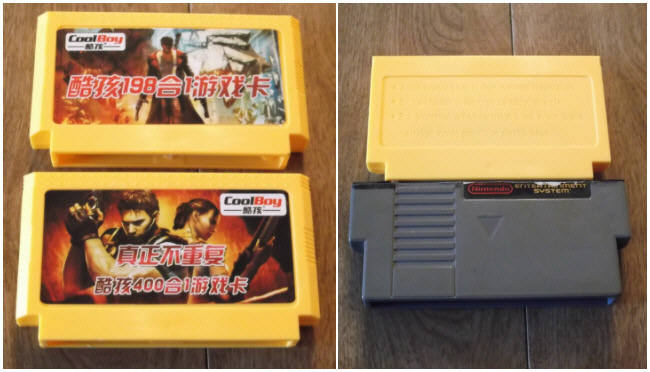
CoolBoy "198 in 1" and
"400 in 1" cartridges along with a custom made Famicom to NES converter
While the 400 in 1 cartridge contains more total games, I find that the 198 in 1 contains a more interesting mix of titles with less filler. This is due to the 400 in 1 cartridge containing more pirate originals including a rather large library of games released by Thin Chen Enterprise, the Taiwanese company better known as Sachen, history's most prolific producer of unlicensed Famicom games. While these games are an interesting collecting sub-genre onto themselves, and a sadly forgotten part of modern NES and Famicom collector culture, they're not necessarily all that fun to play. It should also be said that the back half of the game list for each cartridge is generally filled with these type of Taiwanese and Chinese pirate original games. The 198 in 1 cartridge isn't too bad in this respect, with fifty or so games falling into this category.
This scope of this ongoing column is to quickly evaluate the 198 in 1 cartridge, fifteen games at a time, until the entire list is completed. Additionally each issue will also evaluate a single game from the 400 in 1 cartridge that does not appear on the 198 in 1 counterpart. For the entire duration of this column, each cartridge will be played on an original toaster-style North American NES console. To convert the bootleg Famicom cartridges for play the NES, I will be using a Famicom to NES converter cartridge built from parts out of an early release copy of Gyromite. As a final note, many of the games contained on these bootleg cartridges have their title screens altered to strip away any copyright dates or the like.
Now, back on to high seas and high excitement!
This issue's fifteen games on the 198 in
1 cartridge are a fairly interesting assortment. We have some arcade
conversions, a much-loved later Disney release, Namco's first foray into
gaming on the Famicom, a blatant clone of an influential arcade classic,
a highly regarded action title, a game that was made illegal shortly after
its release, and one of Nintendo's all time best selling Famicom games.
Let's get started.
CoolBoy Real Game 198 in 1, Games 46 - 60:
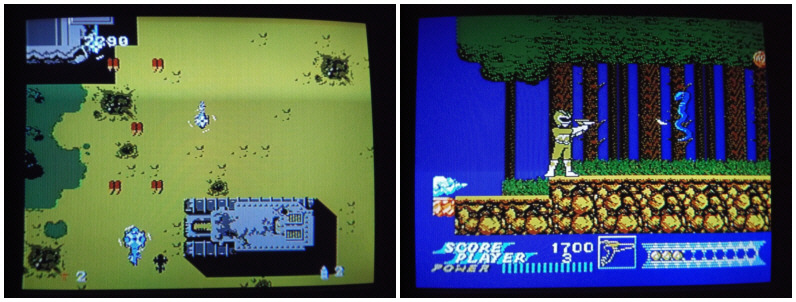
Kyuukyoku Tiger and Kyoryuu
Sentai Zyuranger
046. Kyuukyoku Tiger - This bracket of games is kicked off with a shooter, but just not any shooter, a popular one in fact. Kyuukyoku Tiger is the sequel to one of my favorite vertical shooters, Toaplan's Tiger-Heli. While Tiger-Heli is generally regarded as a forgotten relic of the early days of vertical shooters, Kyuukyoku Tiger features presentation that is more contemporary of what was expected in 1987. If the name doesn't sound familiar that's because Kyuukyoku Tiger was released as Twin Cobra outside of Japan with the addition of two-player simultaneous play, hence the name change to "Twin" Cobra. Micronics, notorious for their generally poor quality and buggy arcade to Famicom conversions, developed the Famicom release. Although Micronics also handled the Famicom / NES version of Tiger-Heli, which was filled with their trademark glitches and screen flicker, I actually really enjoy that port and the same holds true for Kyuukyoku Tiger. While the game is far from perfect, it does play a rather enjoyable game of Kyuukyoku Tiger, especially for a Micronics developed title. That said the usual low quality hallmarks of a Micronics game are still on display here. The music is simply terrible, right up there with some of their worst audio packages, and is made up of short high-pitched instrumentations that become very grating, very fast. The game also tends to feel as if the action speeds up and slows down when engaged in a close firefight with an enemy. This also has an affect on the player's firing speed with some of the weapons. Whether this unevenness in game performance is actual or just assumed I can't say, but the speed of the action can feel like it's shifting gears based upon object density and proximity. The Famicom version also was released on the NES, not surprisingly retitled as Twin Cobra, but is otherwise the same game that appeared on the Famicom. Enjoyable for what it is but far from a spectacular shooter.
047. Power Ranger - The title of this one in the game list almost makes it seem like this cartridge was designed for distribution outside of Asia. The actual title of the game here is Kyoryuu Sentai Zyuranger, based upon Toei's live action Super Sentai television series of the same name. Although Kyoryuu Sentai Zyuranger was the sixteenth series in the Super Sentai franchise, it was the first to be redeveloped to become what is known as Mighty Morphin Power Rangers for American audiences. Although the game was released on the Famicom in 1992, roughly only a year before Power Rangers first aired, by the time Power Rangers mania was in full swing the NES was nearing its last days. With marketing focus being shifted toward the Super Nintendo, the game was never localized outside of Japan.
When one considers all the terrible licensed games that were released on the NES it's kind of a shame that Zyuranger didn't make the trip over. The game is a well designed, smoothly playing action platformer with large sprites and detailed illustrations of series characters. The game features five linear stages, one featuring each Zyuranger, with the ability for each character to pick up their signature weapon near the middle of each stage. A boss battle rounds out each stage and mini games are presented in between that range from a quiz game to a Pong clone. All said it's a nice little package but in addition to its release year I can guess other reasons as to why it was never localized. There is almost zero emphasis put on the robots, which were always the biggest piece of the Power Rangers merchandising pie. Collecting ten coins in a stage replenishes the energy bar and displays a picture of the current Zyuranger's robot along with some stats but that's it. Two of the mini games feature the robots but their inclusion comes across as an afterthought more than anything else. Although all the Zyurangers are in the game, and are shown together with the Howling Cannon after each boss is defeated, the entire adventure plays out as five isolated single player stages. Additionally although there are two different difficulty modes, even on the easy setting the first boss is a little difficult for a game that would have been marketed toward kids, as it requires almost Ninja Gaiden level timing albeit with larger sprites and a much shorter attack range. As it is missing robot battles, doesn't really emphasize teamwork, and has an unbalanced difficulty curve, I can see why it wouldn't have been a good fit for the American launch of Power Rangers - at least considering the original target demographic.
Although I enjoy Japanese tokusatsu and battle team programs and similar anime, as an early teen I absolutely hated the Power Rangers. At the time I considered it a rip off of all the battle team mecha anime that I enjoyed - how arrogant and ironic is that? I thought the whole thing was lame and laughable at the time and kept my distance. That said, years later I was able to better appreciate and enjoy the source material that a lot of these shows were localized from. I still find the Power Rangers rework, and its "let's go down to the juice bar" ascetic, absolutely ridiculous to this day. Even so, this is a cool little game and it's worth checking out even if it won't take you very long to get through it.
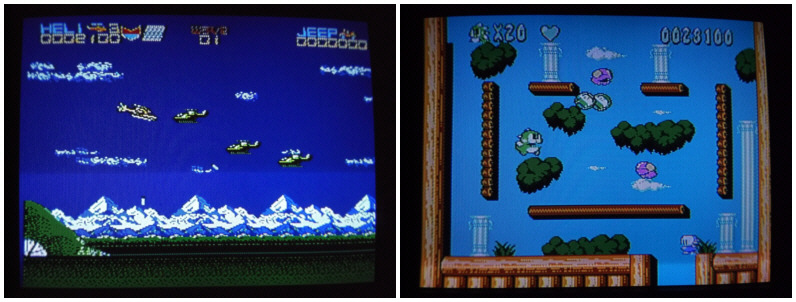
Silkworm and Bubble Bobble
2
048. Gulf War - With a title like that in the menu I assumed this would be Commando or Ikari Warriors or something like that but thankfully it's Silkworm, a really unique arcade shooter. Silkworm is a two-player shooter with a difference. Player one controls an attack helicopter that fires both forward and diagonally downward and has full movement. Player two controls a Jeep that drives along the ground and features a mounted turret that can be positioned in one of five directions ranging from directly in front to directly behind. Additionally the Jeep can jump to avoid obstacles, which will also fire a short-range diagonally downward shot. Although in a single player game either vehicle can be selected, Silkworm really shines with two players, one in the sky in the helicopter and the other on the ground in the Jeep. As the vehicles feature weapons that are complementary to one another, there is a tremendous amount of strategy at play and Silkworm remains one of the best two-player shooter experiences ever created. The NES conversion plays wonderfully and has solid visuals and sound, surprising considering just how much is going on at all times. While playing the one-player mode may make the game seem like a passable shooter at best, I encourage everyone to try this game with a friend. It's a title that no one really talks about when discussing great two-player games on the NES, making it a bit of a hidden gem.
049. Bubble Bobble 2 - The Bubble Bobble games have a confusing chronology but Bubble Bobble 2 is a Famicom sequel to the original arcade game. Its late release date and low production numbers can make it a difficult game to find. The game had its title slightly altered to Bubble Bobble Part 2 for the NES release but it is the same game as Bubble Bobble 2 on the Famicom. The version included on the multicart is the Japanese release with a few changes. First and foremost it is single player only. For Bubble Bobble 2 this isn't a big deal as while the game originally had a two-player mode, play alternates from one player to another rather than simultaneously at the same time. Another change here is that the game has been hacked to start the player with twenty lives. Aside from those changes on the multicart, Bubble Bobble 2 plays like a more Nintendo-centric version of the original arcade game. This shouldn't be surprising as the original arcade Bubble Bobble was almost designed as a throwback to the simpler more gameplay focused games of a few years before. The simplicity of that game was one of the reasons I always enjoyed playing it as it featured a very well defined set of rules that put emphasis on player skill to achieve success.
Bubble Bobble 2 features larger and more colorful graphics, nice animation on the bubble dragons and enemies, and the new ability for Bub and Bob to inflate themselves like something out of Dig Dug. Holding down the B Button will cause your bubble dragon to hold his breath. After a few seconds he will begin to float and his movement will be controllable as long as the B Button is held down. Upon releasing the B Button, a spray of three bubbles will be released and the bubble dragon will fall back to the ground. This allows greater flexibility in terms of reaching higher areas and can easily allow an increase the in amount of bubbles on screen. However this leads to the biggest issue with Bubble Bobble 2 and that is the amount of slowdown the game can exhibit when the screen is filled with bubbles. It doesn't take a whole lot to slow the game down, which also slows the music down, and makes the whole thing feel like it's moving through molasses. The biggest offense is that when there are very few objects on the screen the game moves at a breakneck pace, making the slowdown even more jarring. What the game really needs is the performance to be consistently somewhere in the middle between it's fastest and slowest. Even with its uneven speed, a lot of fun can be had here especially if you like the original and are looking for more of the same. Additionally boss battles throughout the game provide a nice diversion and introduce a bit of variety.
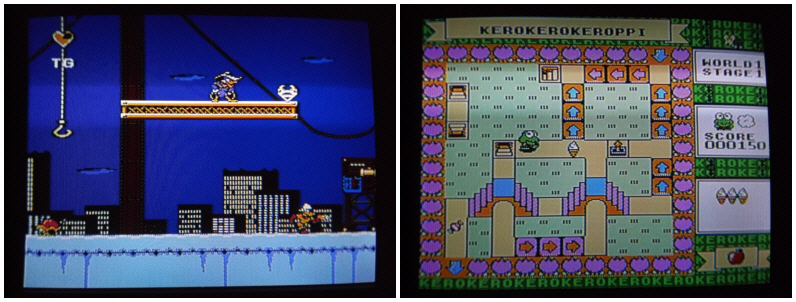
Darkwing Duck and Kero
Kero Keroppi no Daibouken
050. Darkwing Duck - Another Capcom Disney platformer and another game I really don't care for that everyone else seems to love. An earlier Capcom / Disney game, Chip ‘n Dale Rescue Rangers, was number thirteen on the cartridge list, and when it was covered in the May 2016 issue of The Retrogaming Times I said that the game just felt empty. Unlike that game, I'm not a huge fan of Darkwing Duck because of problems with the game itself, but rather because I never really had any attachment to the license. Sure, I watched Darkwing Duck as a kid but it was never my first choice and if I didn't like Launchpad McQuack so much I probably would have never watched it at all. So the notion of these properties being turned into video games was never a big enough draw for me. As most of these games received a large amount of coverage in Nintendo Power magazine, I was always familiar with them and rented them all or played them with friends, but there are no rose-tinted glasses between these games and myself.
Darkwing Duck borrows more than a developer from the Mega Man series - the game feels like it's built upon a later NES Mega Man title. Actually I take that back, to me it plays like a cross between Mega Man and Sunsoft's Batman. Darkwing is armed with a gas gun that can fire three different types of gas. Similar to Batman they all pull from the same ammo pool, or gas can in this case, and drain your reserves at different rates. However the different types cannot be selected at will and instead picking up an ammunition refill will change Darkwing's current gas type to the most recent corresponding gas pickup type. Darkwing himself is nicely animated and controls smoothly, as is expected from a Capcom game of this vintage. I like that he has both the ability to duck down as well as shield himself with his cape. If there is one big gripe I have with the controls it's that Darkwing has a tendency to feel a little heavy in the air. Holding the A Button while performing a jump will allow a smooth, controllable arc but the instant the button is released, even if just for a moment, Darkwing falls like he's made of stone. He can also grab onto platforms from below and jump up onto them but this often becomes more of a liability, as dropping down through a platform is a two-step process in this game. It requires first holding Down on the directional pad and pressing the A Button simultaneously to drop through the platform, but as Darkwing passes through he will automatically grab onto it, necessitating a second press Down on the directional pad to let go. It may not sound like a huge deal but the single input drop down of games like Contra would really help here. Other than those minor complaints this is a decent action game and if you're a fan of the Darkwing Duck property then you'll probably have a great time.
051. Kero Kero Keroppi - Sanrio, the character merchandising company most well known for creating Hello Kitty, added a frog character named Keroppi to their lineup in 1988. Keroppi would prove to be a popular addition, especially on the Famicom where he stared in a puzzle game, a platformer, and an RPG. Keroppi was also featured in a Sanrio themed variation on Pong that plays like a cutesy version of Discs of Tron. The game here, Kero Kero Keroppi no Daibouken (Kero Kero Keroppi's Big Adventure) is a fun little puzzle game aimed at children and was also the first video game to feature Keroppi. It essentially plays like a gentler version of Adventures of Lolo / Eggerland with more of an emphasis on simply moving Keroppi through the stages to the exit of each. Each world features four types of stages that present different hazards and require different types of problem solving to complete. The simplest involves following a path to the end. Another has directional blocks that can only be traveled upon in the direction they are pointing, and also features staircases that allow Keroppi to travel underground similar to the 1996 Game Boy action puzzler Mole Mania. Yet another type features lily pads intermixed with tiles that look like something out of Pipe Dream. These rotate when moved onto and restrict the direction in which they can be moved off of or onto. The final type of stage takes place on what amounts to a giant Reversi board, where two-colored tiles flip over when stepped on. Flipping a tile adjacent to a tile of the same color, with tiles of the alternate color in between them, will cause all tiles in the middle to flip over to the bookended color as well. Additionally Keroppi cannot step or leap onto a tile of the alternate color that he is standing on. This type of stage is the most complex of the four and can actually create a decent challenge as the game rolls on. In all stages Keroppi can either walk the distance of one square or leap the distance of two, as long as a rule of the specific stage does not prevent it. Another Sanrio character, a little girl rain charm named Teruteru, accompanies Keroppi throughout the game and draws the path for him to follow in one of the stage types.
The entire game is very colorful with outstanding visual reproductions of the Sanrio characters in the stage selection and celebration screens. While the smaller sprites used during the actual gameplay stages aren't as detailed, they still accurately represent the colorful world and cute design of the characters. I do have to mention that the controls are a little stiff, especially for a game designed around moving through puzzle environments. This may be a little frustrating to some players and it definitely creates a bit of an unwarranted learning curve for such a simple game. Those who stick with this game through the first couple worlds will find a reasonably enjoyable puzzle game that slowly builds to a decent challenge, especially for younger gamers. Appropriate for all ages, it's not bad at all for a licensed game, especially one featuring Sanrio characters.
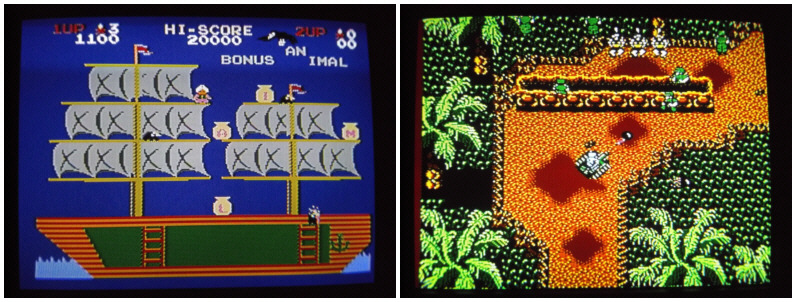
Super Arabian and Guevara
052. Arabian - A home conversion of Arabian, the 1983 arcade game by Sun Electronics, Super Arabian shows us two things: One, that developers loved putting "Super" in front of game titles long before the Super Nintendo. Two, that Sunsoft was making some pretty lackluster Famicom games before the era of Blaster Master and Batman. I really like the arcade game Arabian and find it controls well, has bright and colorful visuals, and entertaining music. In fact I can play the arcade Arabian for the better part of an hour and have a great time. While Atari distributed the arcade game in the USA, Super Arabian never made its way out of Japan. This is for good reason as Super Arabian is a home conversion that looses nearly all of the charm that the arcade original had. The game's objective is to collect all the lettered jugs on a screen, earning bonus points for collecting them in the correct order to spell a word. In the arcade original, the bonus word to be spelled was "ARABIAN" and was the same on every stage. The one minor enhancement of the Famicom version is now there are more words to spell if you want the bonus but all it amounts to is collecting the jugs in a different order. The game is otherwise exactly the same except all of the audio and visual interest has been stripped out. Super Arabian has music and sound effects that are grating to the ears and are easily some of the worst ever heard on the Famicom or NES. The colorful visuals of the arcade game have been replaced with washed out pastels that provide next to no differentiation between objects. The biggest offense is how bad the control is. Arabian, along with another Sun Electronics game, Kangaroo, is often criticized for not featuring a jump button. Instead the arcade game requires pressing up to jump or diagonally up to make a super jump over gaps. Well, the Famicom version moves the jumping control to a button and guess what, it just doesn't work with this game. Vertical movement seems strangely disconnected with the control change but that could also be due to the terrible collision detection in the home version. The other button is used to kick enemies away, as it was in the arcade, but the timing is extremely difficult to pull off consistently here. All of these problems conspire together to make Super Arabian ridiculously frustrating and one of the worst Famicom games I have ever played. There is simply nothing here that is remotely redeeming and that's coming from someone who is a big fan of the original arcade game.
053. Guerilla War - Although listed in the menu as Guerilla War, and although that's the title the game is known as in the United States, this is actually the Famicom version, titled Guevara. While the player characters are simply stock unnamed commandos in all versions released outside Japan, in this version as with the original arcade release, they are in fact Che Guevara and Fidel Castro battling to liberate Cuba in the late 1950’s. This type of fast action combat shooter is one of those genres that rarely translate well into the home. Generally there's either too much action for the less powerful home hardware to handle or a unique control scheme that is poorly suited to a standard control pad. While the NES conversion of Commando was decent at best, and the NES release of Ikari Warriors outright terrible, Guevara is, incredibly enough, an extremely enjoyable and smoothly playing game. In fact Guevara is the exact opposite of what one might expect, as the deck seems stacked against it from the start. To begin with, the arcade original used a rotary joystick to control the direction in which the player is facing. While this allows firing in a different direction than movement, it can make these games virtually unplayable with a standard joystick. Thankfully that's not the case here as although you will always fire in the direction you are facing, the control response is quick enough so you never feel like you're being overwhelmed with the controls. If anything the simplicity and reliability of control input in Guevara is the cornerstone the rest of the game is built upon. One button shoots while the other throws grenades and is used to enter and exit tanks.
With the controls reworked to a superb degree, the next sticking point with a game like this is gameplay performance. As with control, Guevara has been optimized for the Famicom with the main emphasis being to keep the game as fast paced as possible. Sure there's sprite flicker and slowdown but it never negatively affects control response within the game. Where slowdown and flicker in other similar titles will almost always result in an unfair death, that doesn't happen here. Even with two players the action remains fast, frantic and enjoyable. That's how a two-player action game is supposed to be! The levels are also extremely visually diverse and nicely detailed, making the entire game a varied joy to work your way through. It's a flat out travesty that this game has been forgotten and largely ignored by so many. It deserves a place right up there with the Contra games as examples of outstanding two-player shooter action on the NES. This is definitely one worth playing and is also a relatively easy to find and low cost game. Unfortunately the multicart version exhibits minor graphic distortions in the form of horizontal lines that flicker throughout the screen in some areas. While this is only mildly distracting, it is a glitch not present on a retail cartridge. It is possibly an artifact from modifying the game data to remove the SNK copyright introduction on the multicart version.
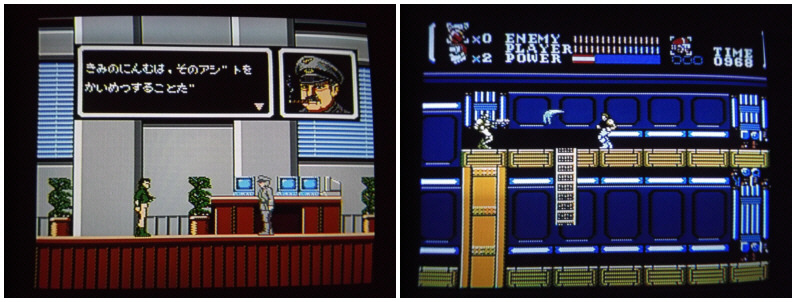
Ningen Heiki Dead Fox
and Power Blade
054. Dead Fox - It's said that imitation is the sincerest form of flattery. With that in mind, someone at Arc System Works must have really liked Namco's Rolling Thunder, as Ningen Heiki Dead Fox (Human Weapon Dead Fox) is a pretty blatant Rolling Thunder clone. In fact if someone didn't know better they could easily assume it was a Rolling Thunder sequel or spin-off. This game was released in the USA as Code Name: Viper but the Japanese Famicom version is the one included on the multicart. It cannot be stated enough how much of this game is taken from Rolling Thunder. It's just not the basic gameplay of Rolling Thunder that is cloned, but pretty much every piece of game design that it featured. Ducking into rooms to find additional ammo, weapons, or just to evade enemies works exactly as it does in Rolling Thunder. Speaking of enemies, they are color coded to denote their strength and attack movements, just like in Rolling Thunder. Heck, even the swanky 1960’s spy music sounds as if it was flat out taken from Namco's game. All of the player's movements are a nearly a carbon copy of those of Albatross from Rolling Thunder. Even that lunging jump animation, where Albatross tucks his legs beneath himself, is copied in Dead Fox. Of course this means it has some of the platforming quirks of Rolling Thunder, such as not being able to jump diagonally. This means you must sometimes backtrack a little, jump straight up onto an upper level, and then jump forward to pass beyond vertical barriers. The forward arc of Dead Fox / Viper's jump can also sometimes get him into trouble as it tends to make him lunge forward, making small jumps difficult - just like in Rolling Thunder! Platforming as a whole is a little clunky using this movement style and that's one place where I think Dead Fox goes a little overboard a little early. Jumps that would be relatively simple in most action games require precise timing here, along with rocking the directional pad back and forth while in mid jump to bleed off Dead Fox / Viper's forward momentum. Running down hallways and climbing a bit with these controls isn't a problem but clearing chasms that lead to instant death is.
While Rolling Thunder influenced many games that came after it, they were games that where influenced by it, not cloned from it. Shinobi by Sega is a good example of a game that owes a small debt to Rolling Thunder's design. Well, the designers of Dead Fox must have liked Shinobi too as they copied some of its concepts as well! Namely that behind some doors in Dead Fox there are hostages to rescue. While these may seem optional, each stage also has a soldier being held hostage. The soldier must be found as they will give Dead Fox / Viper a grenade required to complete the stage. My biggest issue with the game is that many stages have a lot of vertical movement. Generally this isn't a problem but jumping downward once the screen scrolls up is always a total crapshoot. Very frequently you will drop down a level right onto an off-screen enemy or even worse into an instant death pit. While even Rolling Thunder isn't completely exempt from these design issues, they occur far less frequently and are better folded into the platforming challenges of that game.
Thankfully, I really like Rolling Thunder. If you too enjoy Rolling Thunder then you will more than likely get some enjoyment out of Dead Fox. Although the platforming irritates me, it should be said that in Rolling Thunder, Albatross could not change direction in midair after beginning a jump. In that respect Dead Fox could be said to enhance the control input. However the jumping required in Rolling Thunder wasn't often complex enough to warrant such additional control. Although Dead Fox increases the degree of movement in this respect, its level design often makes it more of a necessity that creates its own new control issues, rather than enhances the gameplay.
055. Power Blade 1 - Yet another game I don't care much for that seems to have nearly universal praise from everyone else. Power Blade is set in the year 2191 where a powerful Master Computer maintains mankind's existence. Of course something goes wrong with the Master Computer's control program and mankind is plunged into chaos. The player assumes the role of Nova, a man tasked with destroying the Master Computer and restoring order to society. To gain access he must first locate six agents who are holding ID cards that grant access to the security room in each sector. Each security room has a tape unit that is used to disconnect that respective sector from the Master Computer. Once all six sectors are disarmed, he can then proceed to the control center and destroy the Master Computer. So in essence you play as a computer technician who looks an awful lot like the modern design of Duke Nukem.
What sets Power Blade apart from other action games is the titular weapon. Rather than using a gun, sword, or whip, Nova is armed with boomerangs. Subsequent item pickups and power increases build up an attack power bar similar to The Legendary Axe on the TurboGrafx-16 and Astyanax on the NES as covered in the previous issue of The Retrogaming Times. Where the power bar in those games measured the damage your weapon would deliver, the power bar in Power Blade measures how much distance your boomerang will cover before turning back, with rapid throws covering less distance. While many consider the game to be similar to the early Mega Man titles due to its platforming and weapon elements, as well as the ability to select the order in which stages are played, I've always felt the game has more parallels with Castlevania. Developer Natsume was certainly channeling Castlevania when it comes to the music of Power Blade. With that said it shouldn't be surprising that Kinuyo Yamashita is responsible for Power Blade's soundtrack. She's probably most well known for composing the music for the original Castlevania. Seriously, these sound like lost Konami tunes from a forgotten NES Castlevania title. Heck there are even bats in the game that look like they are direct lifts from the bats in Castlevania. Nova's sprites and animations are obviously inspired by Bill and Lance in the Contra games, except he has a ridiculously exaggerated running animation. The guys in Track & Field don't pump their arms that much when they run! And this leads to where my problem with the game has always been - the controls. Although Nova can throw his boomerangs very quickly, in eight directions, overall control simply seems stiff and heavy. While control response is fast, Nova has a clunky weight to his movements that feels at odds with the high speed in which he can deliver an attack. While this doesn't break the game in my opinion, it does prevent it from being elevated beyond a standard action title on the platform.
The USA version is what is included on the multicart. The original Japanese title, Power Blazer, is actually significantly different. I have no problem admitting that Power Blazer is essentially a game in the style of Mega Man, both in terms of level design and visuals. Power Blade is a near total rework and redesign of Power Blazer, pretty much from the ground up, and really only retains the stage select structure and boomerang weapon from the Famicom game. Controls are even stiffer and slower in the Famicom version and the stage designs are much more linear, keeping more in line with early Mega Man games. While Power Blade is a massive improvement over Power Blazer, I feel it is an average action platformer at best. People seem to really love Power Blade though, so give it a try.
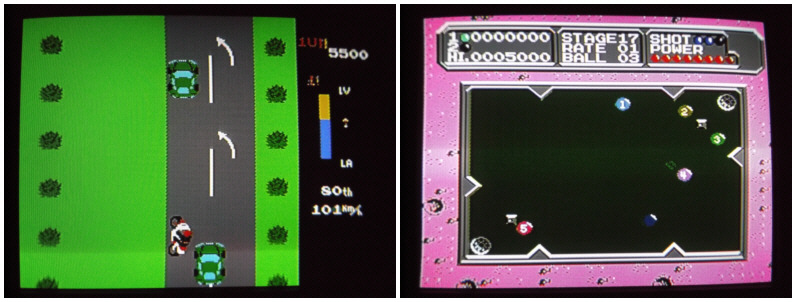
Zippy Race and Lunar
Ball
056. Zippy Race - Ugh... This column is going to make me lose my mind. Not only has this bracket of games subjected me to one of the worst Famicom games ever, Super Arabian, now it's serving up another game I hate. The difference is that Zippy Race, also known as Traverse USA and MotoRace USA, is a game I hated even in the arcades. Now I seem to be one of the very few people who really detest this game and I figured it was because I hadn't played it on actual arcade hardware in many years. Due to that I gave my opinion of the game a tentative pass of indifference. So at the California Extreme 2016 arcade show I made a point of putting in some real time with an original MotoRace USA cabinet, licensed and manufactured by Williams in the USA. I will admit that the game does in fact play better with the correct joystick providing resistance back to center, making the game feel more as if you are controlling a motorcycle. Even with that said, I still absolutely hate this game and find it extremely cheap and annoying with no redeeming qualities what so ever.
Zippy Race has a cool premise, an overhead cross-country motorcycle race through the United States with each stage ending in a behind-the-rider approach to a checkpoint. The problem with Zippy Race is that it resembles less of a motorbike rally and more of a commute at rush hour on some of the country's most dangerous freeways. You don't really race against anything other than your depleting fuel tank. Sure there's a position counter that counts down how many cars you've passed but it's like keeping track of how many cars you pass on the way to work every morning. Traffic doesn't seem like it is racing you but more like it's a bunch of complacent drivers who aren't keeping an eye out for motorcyclists. Nearly every vehicle you encounter will attempt to run you off the road with very little room for improvisation and even less room for error. Of course that's if you can get around the vehicles, as they will block your motorcycle relentlessly, to the point where they will run into one another and bounce along the road edges. This is the biggest problem with the game as overtaking traffic should be a smooth and rewarding experience, not a constant annoyance with the fear of a collision always looming overhead. The road patterns and non-traffic obstacles can be learned through memorization but the endlessly cheap traffic encounters spoil any sense of fun. The Famicom version is actually more difficult than the arcade original as due to the change in screen orientation there is less time to react to the hazards ahead. If you like this type of game, play Namco's Road Fighter instead, released to arcades one year later in 1984. Even the Famicom conversion of Road Fighter, while missing some aspects of the arcade original, is still a ton more fun than any version of Zippy Race / Traverse USA / MotoRace USA. Did this game really need so many names and releases? On the multicart the game tends to exhibit some minor text corruption in the status bar but the game otherwise plays correctly.
057. Lunar Ball - An outstanding pool game with an outrageous assortment of variations, Lunar Ball is the Japanese release of the NES game Lunar Pool. Developed by Compile, a company better known for their impressive technical prowess programming shooters such as Zanac, The Guardian Legend, and Gun-Nac, this game takes the basic concept of video pool and runs with it. Rather than playing on a conventional rectangular table with six pockets, Lunar Ball features sixty different table configurations. It's more of a cross between miniature golf and pool than anything and the concept works surprisingly well. Additionally the friction of the table surface can be adjusted, massively altering the ball physics and changing the difficulty of any table. This creates an insane amount of gameplay variations not seen since early releases on the Atari 2600. The game can be played alone or one-on-one with a friend or against the computer. While there's not a lot of it, the music in this game has always stuck with me through the years, especially the tune that plays at the start of a table. Not a lot can be said about Lunar Ball, as it's a relatively simple game where the appeal is the complexity of its gameplay variations, but everything is done very well and is a lot of fun. How many other home pool video games from 1985 are still enjoyable to this day?
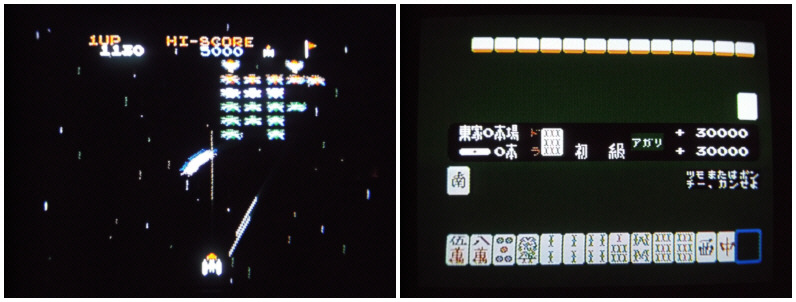
Galaxian and Mahjong
058. Galaxian - If Taito's Space Invaders is one of the most pivotal and games to the history of the video game industry, than Namco's Galaxian should be held in equal regard for being the game that advanced the industry beyond and endless of deluge of Space Invaders clones. Galaxian takes the basic game play of Space Invaders and makes it faster, more colorful and increases the challenge and variety. Enemy invaders now break off from the convoy and directly attack the player's ship, running different attack formations and moving at varying speeds. Galaxian is the game that bridged the inventiveness of 1978's Space Invaders to the refinement of 1981's Galaga. The Famicom conversion of Galaxian does an admirable job of bringing the game home although at the time it was already considered a relic of a bygone age. Rather than reorienting the score, stage and reserve ship status to the side of the screen in an attempt to recreate the arcade vertical screen dimension of the playfield, the entire game is squished down to fit a horizontal orientation of a television. Surprisingly the sprites still look good and aren't too terribly stretched. This change in aspect means that the distance between the player's ship, the Galaxip, and the enemy convoy is considerably smaller than in the arcade version. This makes the game easier as you start right up on the enemy convoy and can quickly get some well-placed shots off at the beginning of a stage to ease the challenge. The aspect change also makes the enemies a little wider and easier to hit, also lessening the challenge. Sound reproduction is accurate although it lacks the intensity of the arcade version's constant droning. This was actually the first game that Namco published on the Famicom but due to the game's relative vintage and "middle child" status in the evolution of early shooters, it never had an NES release. Instead Bandai elected to publish the Famicom conversion of Galaga on the NES, a wiser choice in my opinion concerning the more popular status of the game among the masses. Galaxian on Famicom is still pretty fun and if you like these early arcade shooters it's worth a try.
059. Mahjong 2 - If you know me then you know that one of my favorite online video programs to watch is Chrontendo. Its host, Dr. Sparkle, has been playing not only every Famicom / NES game in the order of their release but also every Sega Mark III / Master System, Sega Mega Drive / Genesis, and PC Engine / TurboGrafx16 game as well - and has been releasing informative and professional videos showcasing this chronological history of gaming for years. In fact former Retrogaming Times Monthly chief editor Scott Jacobi inspired that series in part with his "Nintendo Realm" column from many years ago. Why am I writing about a seemingly unrelated online video program and a column from the previous incarnation of The Retrogaming Times? What does that have to do with Mahjong? Well the Famicom library features a lot of mahjong games so they come up on Chrontendo quite a bit. For a Westerner such as myself there are three types of Famicom games that are difficult to make an accurate analysis of: Japanese text heavy games, shogi games, and mahjong games. I speak and read very little Japanese so that one should be obvious. Shogi is sometimes called Japanese chess, as both chess and shogi trace their roots to chaturanga, an ancient game that originated in India. As I don't play shogi and know very little of its rules, games based around shogi are a complete mystery to me. Mahjong is a Chinese game that rose to popularity in the 1800’s and is essentially a card game played with tiles. While I understand more about mahjong than I do about shogi, I don't pay mahjong and I'm not familiar enough with the game to gauge whether or not a mahjong video game is good or bad. On Chrontendo, Dr. Sparkle is often in the same position. Much like the good doctor, when one of these games comes up, I'm going to solder on the best I can.
What I can tell you about this game is that it shares a release date with another Asian board game on the Famicom, Gomoku Narabe Renju, and these games were actually the fourth and fifth games ever released for the Famicom, back in August of 1983. Unbelievably this humble, early, no-frills Mahjong game, simply titled Mahjong, would end up being one of the best selling pieces of Famicom software ever released. That's just not in 1983 or in the early days of the Famicom - during the entire retail history of the hardware this was one of the best selling games. I honestly can't think of another situation where an early release game, let alone one that is a video conversion of a physical game, outsold most other software for the entire production life of a console, especially one that was as popular and long running as the Famicom. Food for thought the next time you're talking with someone about the most popular 8 bit Nintendo games.
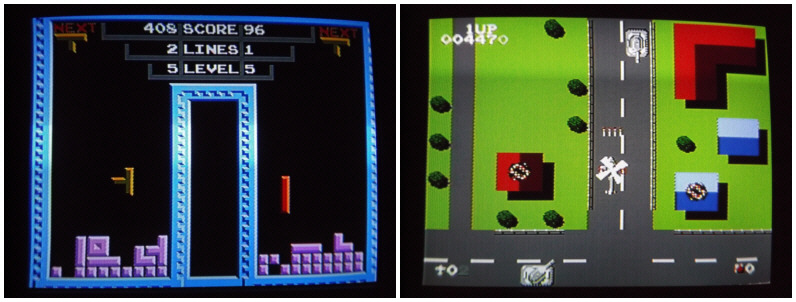
Tetris and Tiger-Heli
060. Tetris 2 - Considered by many
gamers to be the superior NES conversion of Alexey Pajitnov's puzzle game
classic, this is the Tengen / Atari Coin version of Tetris.
The Tengen release of Tetris is based off Atari's arcade version while
the Nintendo licensed release is based upon the earlier Famicom version
from Bullet Proof Software, which itself was based upon the even earlier
computer versions. I'm assuming if you are reading this column then
you know what Tetris is. However if you are somehow unfamiliar with
the game, the objective is essentially to arrange falling blocks in a well
so that they create horizontal rows, where once created they disappear.
If the well fills up to the top you "top out" and it's game over.
The Tengen version features modes for two players that allow both competitive
and cooperative play, the latter featuring a single well that both players
work together in at the same time. The Tengen version also features
more music than the Nintendo release, all of it taken from the arcade version,
and replicated to perfection on the NES. While the Nintendo release
was about slowly increasing block acceleration throughout the endless mode,
Tengen's game is about completing short brackets of stages based around
line elimination goals. This is similar to the arcade version although
the arcade original featured a little more variety in this respect.
If you enjoy Tetris you owe it to yourself to give this version of it a
try if you haven't already - especially if you are a fan of the Atari arcade
version. Although a debacle concerning publication rights lead to
it being pulled from stores shortly after its release, way more copies
are out there than some would lead you to believe. Even with that
said, I can remember "Tengen Tetris" as one of the first NES games to consistently
pull a value of $50 back during the early days of the retrogaming hobby.
CoolBoy 400 in 1 Real Game, Spotlight Selection:
030. Tiger Heli - I'll admit that I'm being a little biased here but it's my column and it's my prerogative. As the 198 in 1 cartridge featured Kyuukyoku Tiger in this bracket, and its prequel is a game I really like that most other people don't, I felt it fitting that Tiger-Heli be the game on the 400 in 1 cartridge that is covered this issue. Us Tiger-Heli fans have to take what we can get! It's not a hard game to find in the least, in fact I would assume that most people who were around during the big days of the NES played Tiger-Heli at least a few times through ownership, rental, or with a friend. Micronics, who was also responsible for Kyuukyoku Tiger on the Famicom, handled the Famicom conversion of Tiger-Heli. Tiger-Heli is somewhat strange for a shooter in that every target encountered is on the ground and pretty much everything on the ground is fair game. Houses, civilian cars, railroad crossing gates - it's all is ripe for destruction and scores points. Although there are enemy planes they are always on the ground, either sitting out in the open or taxiing down runways, and they never fire. In addition to a wide firing cannon the Tiger-Heli can hold up to two bombs and begins each mission with a full complement. Additional bombs as well as support wingmen, called Little Heli, are obtained by shooting flashing cross icons found on the ground throughout the game. The icons cycle through three colors: red, gray, and green. Shooting a red cross dispatches a Little Heli that fires to the side, shooting a gray cross dispatches a Little Heli that fires forward, and shooting a green cross dispatches a bomb replacement. A Little Heli must be collected for it to settle into formation and although only two can accompany the Tiger-Heli at a time, they can be mixed and matched. Bombs are picked up in the same way, by collecting the bomb icon, and the maximum number that can be carried is two. Collected bombs show up attached to the sides of the Tiger-Heli and drop off when fired - a nice visual touch carried over from the arcade version.
Considered a relic from developer Toaplan's earliest days, modern opinion of Tiger-Heli generally ranges from dislike to misapprehension but the game was very popular in its day, especially on the NES. One of the biggest misunderstandings I've read concerning Tiger-Heli is how the bombs work. If an enemy shot impacts the Tiger-Heli on the same side as a stored bomb, the bomb will detach and protect the helicopter. This makes sense, and is a design choice I really like as rather than losing a life you trade away a bomb instead. The detached bomb still explodes and has the same damage radius, so it's not like it completely goes to waste. It seems that many people don't understand this game event and assume that the Tiger-Heli is wasting bombs either due to poor game design or a game glitch. I have also read opinion describing this as an annoyance without realizing that the loss of a bomb rather than the loss of a helicopter is actually way more beneficial to the player. I equate it to someone complaining that they loose fireball power and shrink down to Small Mario in Super Mario Bros. when hit by an enemy. Sure, you lose some advantage but you don't lose a life. Why this is such a hard thing for some to understand in Tiger-Heli escapes me. Catching an otherwise unavoidable enemy shot with a reserve bomb is actually a special strategy and something that I've only really seen in this game. Sure other shooters may use bombs to clear out enemy projectiles, but using the ordinance attached to the side of the player ship essentially as a catcher's mitt enhances this game, rather than detracts from it.
Being a Micronics game there is a hefty
amount of flicker present in pretty much everything that isn't a background
object, including the burned out craters that are left in your wake of
destruction. Following typical Micronics quality, the entire game
has a feeling of barely running properly as it chugs along. However
while the frame rate is low, it is extremely consistent, proving that a
slow running game is far better than an erratically running game.
Even with the all the flicker, enemy shots are always visible and easy
to track, and don't get lost in the slightly twitchy graphics. Control
of the Tiger-Heli, both movement and firing, remains rock solid through
the game as well. Sure the game may scroll slowly and flicker and
flash but you are always in full control and can clearly spot enemy projectiles.
Sound design is accurate to the arcade original and while I can understand
that the same repetitive song that plays throughout the entire game isn't
for everyone, I think it's great. The little tune that plays at the
very beginning of the game, as the Tiger-Heli is revealed lifting out of
a truck, is ridiculously nostalgic for me. I suppose I do have a
bit too much nostalgia for this game but as a home conversion goes it is
extremely solid and very accurate. While not the best game on the
hardware performance wise, if you like the early Toaplan shooters then
you'll enjoy Tiger-Heli.
Next time we'll pick up the list with game
061 on the 198 in 1 cartridge. The next bracket of fifteen games
moves things back to a simpler time on the Famicom with some of the earliest
Nintendo developed titles, a couple early arcade conversions, and a title
that has been hacked to death on nearly every bootleg multicart ever made.
While the games will be from the early years, at least they'll be solidly
designed.
|
I remember the day I waited in line for the Sega Dreamcast. The date was easy to remember. It was strategically done to remember the launch. September 9th, 1999 (9-9-99). I grew up a huge Sega fan and was very excited to get the latest and greatest system, which used state of the art technology and a brand new controller layout to jump ahead of the competition. The controller for the Sega Dreamcast was ahead of its time. From the layout, to the buttons to the VMU (Visual Memory Unit) attachment, it was an exciting time for Sega and gamers all over the country.
At first glance the controller for the Dreamcast was not your typical sized controller. This is pre the original XBOX controller. There were mixed reviews on how the controller would feel and be held based on the large size and shape. Surprisingly the weight itself of the controller is very light and holds nicely in the hand. The shape of the controller made for some uncomfortable gameplay and frustrated gamers. The worst feature hands down is the cord. The cord for the controller was at the bottom, which made the length of the cord shorter based on its placement. This is a surprisingly bad choice from Sega who had some pretty bright people working for them. The directional pads and buttons on the face of the controller feel comfortable enough, but the trigger buttons have some issues. The joystick itself is smooth and fluid. It definitely helps when trying to move around the screen in tricky spots of the game. However, some gamers were excited about the color and look of the controller itself and the arcade feel of the buttons and D-Pad.
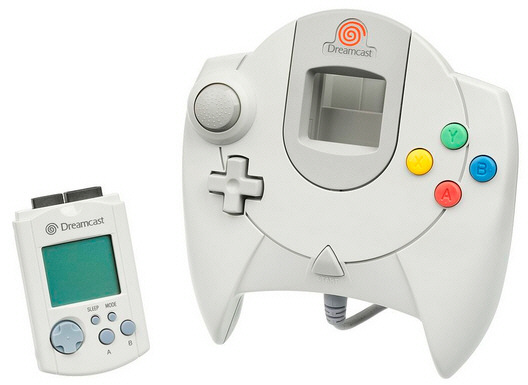
A few games that were my favorite in the early Sega Dreamcast days were Soul Calibur and Ready 2 Rumble Boxing. These games took advantage of the multiple button and triggers on the controller. Soul Calibur was as close as you got at that time to the graphics and feel of the arcade game. Trying to capture combination moves was a challenge and required a lot of practice and skill to master any of the playable characters you choose. The Story mode of the game made the excitement of the fighting genre alive and well. Of course the two player tournament mode was the best way to keep your friends coming back for more. The sounds and music of the game was the perfect addition to making this one of the best fighting games at that time and perhaps today. The more you played this game, the more you would come up with combo moves that would be hard to counter. This made training and practice key for this fighting game.
Ready 2 Rumble Boxing was a very unique boxing game that was fun the moment it began. The choice of different characters added to the enjoyment of the game. The addition of Michael Buffer as the announcer added a realism to the in ring performance. Boxing games have succeeded and failed in the past and present. Mike Tyson's Punch-Out, Evander Holyfield Boxing, Ring King, Fight Night, etc., but to me Ready 2 Rumble is in the top 5 boxing games of all time. Unique characters like Afro Thunder and Tank Thrasher made each fighter use special fighting abilities and finishing punches that made the fighting special each time. The special RUMBLE meter made the final knockout blow entertaining and colorful. Blocking and weaving, along with the multiple punches with the four different buttons, made the boxing fun, real and easy for all ages to play.
Some games took advantage of the unique VMU unit that was an accessory to the controller. This mini electronic unit was like a miniature memory card and Game Boy rolled into one. The VMU unit could add extra excitement to the game as a video or character would be on the VMU screen while you play. It's almost like a pre vision of the Nintendo WiiU gamepad. It also served a time-clock if you preferred. It has a speaker and a control pad as well to use it as a separate entity. Sports fans were excited to see play calling on the VMU when playing NFL 2K.
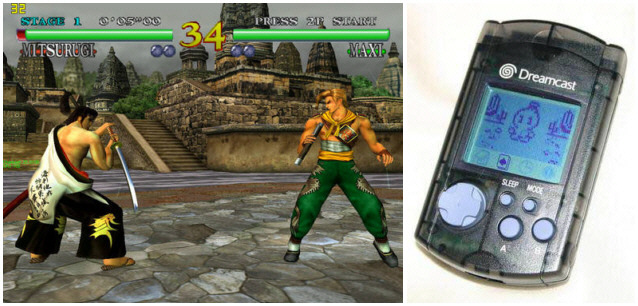
Soul Calibur's impressive
arcade translation was an early system seller (left), VMU functionality
independent of the console (right)
A couple games that took advantage of the VMU technology were Sonic Adventure 2 and Sonic Shuffle. In the Sonic game, players could transfer Chao eggs to the VMU and play in various mini games involving their hatched Chao. Once you strengthen your Chao you can upload it back into the Dreamcast game to use in future play. This was way ahead of its time and in the end perhaps gamers were not ready for that, as it did not take off as Sega had hoped.
Overall, this controller was a beautiful representation of change in the gaming industry in the late 90's and early 2000's. The sleek look and white color along with the colorful buttons and VMU gameslot really took on a world of its own with the fans. It was definitely a popular item to have back in the day and I was one of the proud first owners of the system on day one. I still have the original system and controller from 9-9-99 and still play games on the Dreamcast to this day. Without the unique controller, this system may have folded quicker than it did. I am sure there were changes that should have been made but I am happy with the final product.
Next issue we will explore the system that
tried to take down Atari and to some people did. It had one of the
most over rated controllers in the industry, and in my opinion was the
most difficult controller to use on a gaming device ever - the Intellivision
controller.
|
I went through a very dark period a few years ago, the kind of deep seeded depression where you truly do not care what becomes of you. There was one friend that was there and made sure I was getting out of the house and being around people when I needed it the most, helping me through to the other end. At the time I had a big collection of soft modded Xboxes loaded with emulators. One of those Xboxes was the main feature at a lot of get togethers.
The big hit at these events was Bomberman 94 for the PC Engine. Anthony, my best friend, always brought a diverse cast of characters together and many people turned up for these Bomberman sessions at one point or another. Mostly his family was there, brothers Kyle and Gage, and cousin Richie. The beauty of the Bomberman series is its simplicity. Within minutes anyone can pick it up and play well enough to have an amazing time.
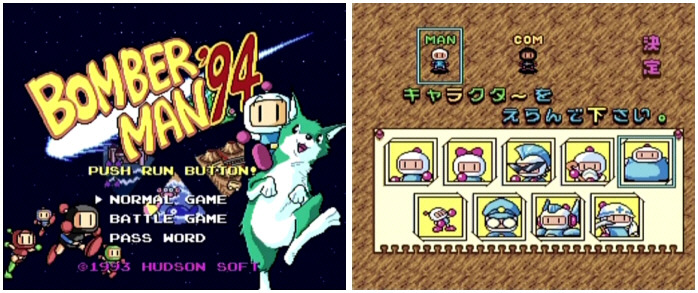
Kyle, the second oldest brother, was working at a Lee's Chicken at the time and was an expert in eating well, as all members of his family are. At the end of his shift he'd have tons of unsold chicken to contribute to the Bomberman parties. Being the enterprising youth that he was, he would use the chicken as a bartering tool with other restaurants and made deals with other fast food establishments in the area, trading chicken for other delights. This would fuel the Bomberman parties well into the night. There were many memorable events at these Bomberman parties. The youngest brother, Gage, was a regular at the Bomberman parties as was cousin Richie. I don't have much to say about cousin Richie but he was there a lot of the time. Then there would be other friends swinging by for a Bomberman session or two randomly.
For a few months the Bomberman parties would be a regular feature at Anthony's house. I'd come over set up the soft modded Xbox and we'd load up some Bomberman. Before long there were house rules. One of the Xbox emulator features is speeding up the emulator by holding down the left trigger. HIGH SPEED Bomberman was especially popular. After a while of playing the game at this frantic speed, playing the game at its intended pace was a breeze. This brought up Anthony and Kyle's proficiency with Bomberman incredibly fast. I myself being a long time fan of the series started out with a pretty solid advantage but it wasn't long before they were picking up and mastering the game. Especially Anthony, my biggest competition, but I suspect he may have just been lucky. One can never truly tell with Bomberman. One of the multiplayer levels in Bomberman 94 has a gimmick of increased speed playing this level with the sped up emulator was an absolute joy.
Bomberman 94 wasn't the only game featured, there was a rotation of Bomberman and Bomberman 93 for the PC Engine as well. Occasionally we loaded up Bomberman 2 for the NES when there were just three of us playing. Using the series as a gateway I introduced Anthony to Game Center CX with the Bomberman episode. It was well received.
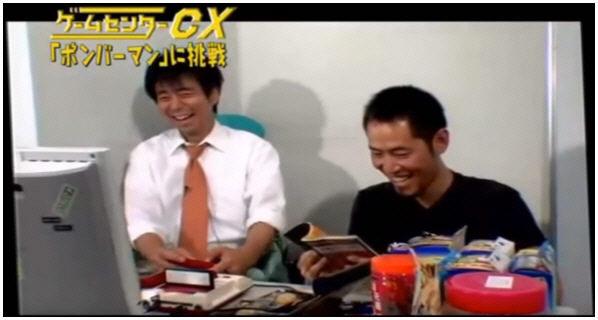
Shinya Arino (left) and
Shinichiro Tojima (right) playing through the Famicom release of Bomberman
during a DVD bonus episode
of the Japanese retrogaming themed TV show "Game Center CX"
Of course other games were featured at these gaming sessions. With cousin Richie I played and beat Contra, Kyle and myself networked a pair of Xboxes and played through Halo 2's co-op story mode. Lots of cheap alcohol was consumed and more fried chicken than mere mortal men should have had access to was devoured. It was Bomberman however that drove these get togethers and really made an impact on all of us.
While still in that dark depression my other friend Arthur, a tattoo artist, asked me if I wanted a free tattoo as he had done many times over the five or so years leading up to that point, as he was apprenticing and starting his career. This day however was just the right day and I said, "Sure." In memoriam of the exciting Bomberman parties I got a tattoo of the Black Bomberman. It was a reminder of a time when I needed people to be there and they were. About five months ago I lost my best friend Anthony. He was consumed by a heroin addiction and was found by his mother, overdosed. I'm very much a part of his family and was deeply impacted. I performed his brother Kyle's wedding ceremony and I was given the honor of delivering his eulogy.
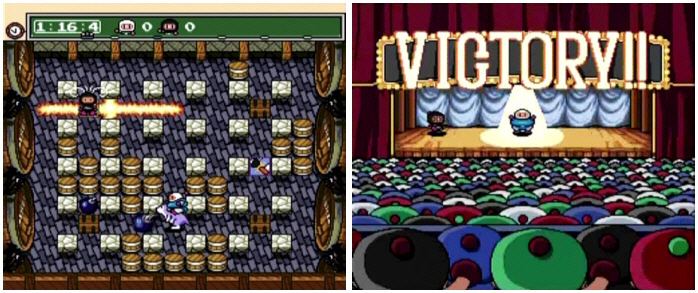
Not a day goes by that I don't think about the good old days of our youth when we were always up to something, hatching a scheme or trying to get some free chicken, seeing if we could trick someone into taking us to the zoo, exploring an abandoned building or some other nonsensical plot. But the brightest memory is the months long period where Bomberman parties brought us all together to laugh, eat and be merry.
Jerry sporadically produces a video
game podcast called The Mondo Cool Cast, featuring all eras of video gaming.
It can be found on iTunes and at www.mondocoolcast.com.
He also produces a cable access show about video games, which can be found
at www.youtube.com/jerryterrifying
along with other video gaming focused content.
|
In early October I was talking with a couple gentlemen during an interview unrelated to video gaming but classic gaming and the term "retrogaming" came up during our discussions. As I explained in the last issue, retrogaming didn't appeal to me because it was something different, to me the older games never stopped being fun as something new was released. In that way playing older video games wasn't a movement or a hobby, it was just normal entertainment. In those days, as older hardware was discontinued it was an opportunity to pick up games you might have missed or go bargain hunting for titles that looked interesting - sometimes even picking up brand new discontinued hardware. This is nearly a total counterpoint to how discontinued hardware works with today's games as the trend is to totally remove oneself from a previous generation once the new one hits. Yet is this really anything new? Is it really different from how it once was? For the masses, no, it isn't anything new as discarding one generation back is what lead to the original rise of retrogaming. After a few hardware generations some people began to get curious concerning what came before.
Getting back to the discussion concerning retrogaming I was having in early October, the conversation turned to the universal question of, "What is retrogaming?" Personally I've always seen it as a sliding scale and not simply one defined by taking the current generation of gaming and deducting a pair of generations off of it. To mark a specific era of gaming and say, "Those will never be considered retrogames!" is honestly pretty ridiculous. That sliding scale will always create a new sweet spot for people who wish to rekindle nostalgia, are curious about alternate hardware than what they owned at the time, find affordable hardware second or third hand, are in the mood for something more obscure, or a myriad of any other possibilities including mine - that older games never stopped being fun in the face of new advances. I'd say what pushes the value around more than anything else however, is the first point - nostalgia. That is, coming into disposable income coupled with nostalgia, which generally feed off one another and often times occur hand in hand. I think a good portion of us have experienced that at one time or another. It's the key reason, in my opinion anyway, that you can see an uptick in interest surrounding the Nintendo 64 for example - hardware that maybe had five or so truly great games. Again, my opinion. Retrogaming is whatever you want it to be, whatever era, whatever hardware. To me, retrogaming is different for everyone and that's what makes it universal to everybody. While we all haven't played the latest new thing, I'm sure all of us have played something before and because of that we are all retrogamers.
Thank you once again for checking out The Retrogaming Times, especially if you've been with us all year long. We'll be back on January 7th with our next issue, the first one of 2017! Be sure to follow The Retrogaming Times on Facebook and join our new community! I sincerely hope you enjoyed this issue and that you will return to read the next issue and possibly submit an article yourself. Remember, this newsletter can only exist with your help. Simply send your articles directly to me at trt@classicplastic.net or check out the submission guidelines on the main page. Submit an article today and join a great retrogaming tradition!
See You Next Game!

Content and opinions on this
page are those of their respective writer(s)
Assembled and published
by David Lundin, Jr. on November 1st, 2016 at ClassicPlastic.net
© 2016 The Retrogaming
Times. All Related Copyrights and Trademarks Are Acknowledged.